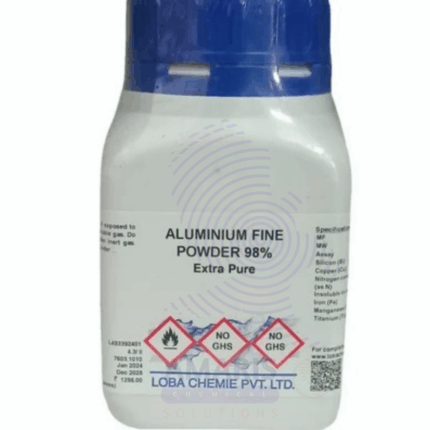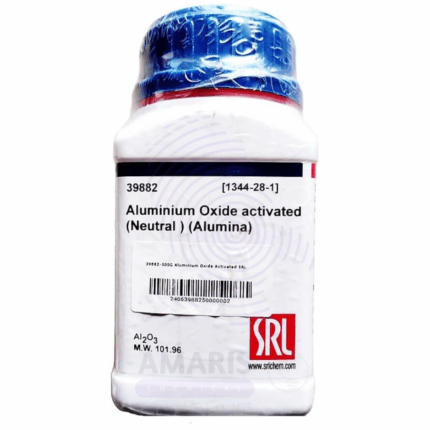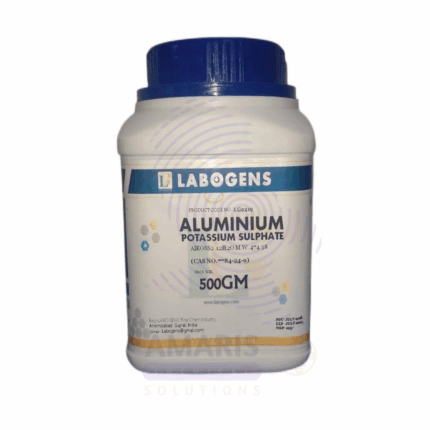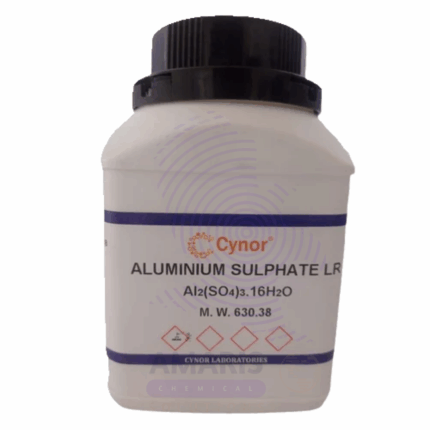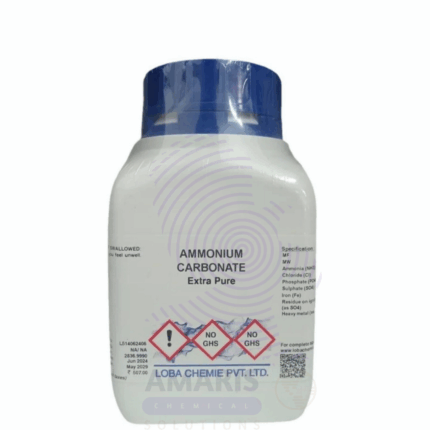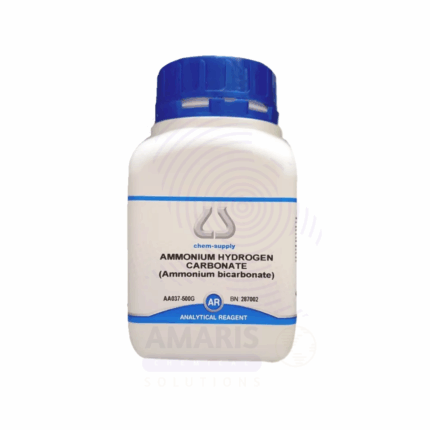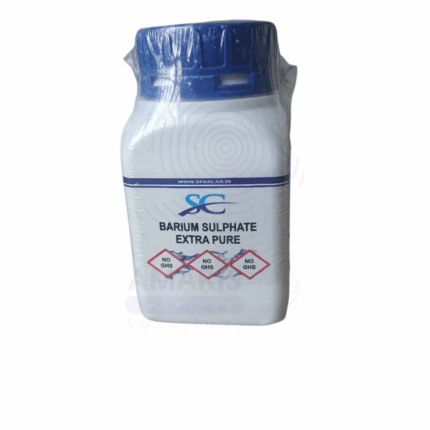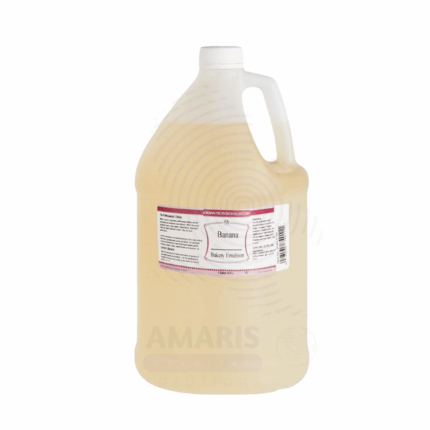
Aqeous Ammonia Solution Extra Pure
$ 30.00 Original price was: $ 30.00.$ 29.45Current price is: $ 29.45.
Aqeous Ammonia Solution Extra Pure is a high-purity, clear, colorless liquid consisting of ammonia gas dissolved in water, emitting a strong, characteristic odor. It is widely used in laboratory chemistry as a weak base and complexing agent in acid-base titrations, buffer preparation, and qualitative inorganic analysis, particularly for detecting metal ions through complex formation. It also plays a role in pH adjustment, sample preparation, and synthesis of ammonium compounds. The extra pure grade ensures low levels of impurities, making it ideal for sensitive analytical procedures and high-precision research. Due to its volatility and corrosive nature, it should be handled in well-ventilated areas and stored in tightly sealed, chemical-resistant containers away from heat and direct sunlight.
Aqeous Ammonia Solution Extra Pure
Primary Uses
- Alkaline Reagent and pH Adjuster
- Commonly used to raise pH in titrations, buffer preparation, and general aqueous reactions.
- Complexing Agent in Inorganic Analysis
- Forms ammonia complexes with metal ions (e.g., Cu²⁺, Ag⁺, Ni²⁺), aiding in qualitative analysis and separation of cations.
- Precipitant in Group III and IV Inorganic Qualitative Analysis
- Used to precipitate metal hydroxides such as Fe(OH)₃, Al(OH)₃, Zn(OH)₂ under controlled pH.
- Neutralizing Agent in Acid–Base Titrations
- A weak base used in titrations and buffer studies, especially for demonstrating weak base–strong acid behavior.
- Preparation of Ammonium Salts and Lab Reagents
- Reacts with acids or acidic oxides to form ammonium salts (e.g., NH₄Cl, NH₄NO₃) for synthesis or calibration.
Secondary Uses
- Cleaning Agent for Glassware and Electrodes
- Removes organic residues or metal deposits from lab equipment, especially when combined with peroxide or acids (used with caution).
- Reagent in Nessler’s Test for Ammonia Detection
- Forms colored complex with Nessler’s reagent — useful in trace ammonia or nitrogen analysis.
- Reducing Agent in Redox Systems (Mild Conditions)
- In select systems, can act as a reducing agent or participate in redox equilibria (e.g., silver oxide reduction).
- Ligand in Coordination Complex Synthesis
- Introduces labile NH₃ ligands into metal centers in coordination and transition metal chemistry studies.
- Demonstration of Gas Solubility and Equilibrium
- Used to show Henry’s Law, dynamic equilibria, and acid–base gas absorption phenomena.
| PACK SIZE |
2.5 Litres Glass bottle |
|---|
1. Basic Identification Attributes
- Chemical Name: Ammonia Solution (Aqueous Ammonia)
- CAS Number: 1336-21-6
- HS Code: 28142000 (Ammonia in aqueous solution)
- Molecular Formula: NH₄OH (often written, though it exists in equilibrium as NH₃ + H₂O)
- Synonyms:
- Aqueous ammonia
- Ammonium hydroxide
- Aqua ammonia
- Ammonia water
2. Physical & Chemical Properties
- Physical State: Liquid
- Color & Odor: Colorless liquid with a strong pungent, ammonia-like odor
- Boiling Point: ~27–33 °C (for concentrated solutions)
- Melting Point: ~−57.5 °C
- Density/Specific Gravity: ~0.91 g/cm³ (for ~25–30% NH₃ solution)
- Solubility:
- Water: Completely miscible
- Ethanol: Soluble
- pH Level: ~11.6–12.5 (depending on concentration)
- Vapor Pressure: High – releases ammonia gas readily
- Flash Point: Not flammable, but ammonia vapors are flammable in air (~651 °C autoignition)
- Autoignition Temperature: ~651 °C
- Viscosity: ~0.88 mPa·s
3. Safety & Hazard Attributes
- Hazard Class (GHS):
- Skin Corrosion/Irritation (Category 2)
- Serious Eye Damage (Category 1)
- Aquatic Toxicity – Acute & Chronic (Category 2)
- NFPA Ratings:
- Health: 3
- Flammability: 1
- Reactivity: 0
- Exposure Limits:
- OSHA PEL: 50 ppm (35 mg/m³)
- ACGIH TLV: 25 ppm TWA, 35 ppm STEL
- Reactivity:
- Reacts with acids, oxidizers, and halogens
- Can form explosive mixtures with air at high concentrations
4. Storage & Handling Attributes
- Storage Conditions:
- Store in a cool, well-ventilated area away from heat and acids
- Keep containers tightly sealed to prevent gas escape
- Incompatible Materials:
- Acids, halogens (e.g., chlorine), hypochlorites, strong oxidizers, metals like copper and zinc
- Container Type:
- Vented HDPE plastic or glass bottles
- Shelf Life & Expiration Date:
- ~1 year (ammonia concentration decreases over time)
- Special Handling Requirements:
- Use chemical-resistant gloves, goggles, and lab coat
- Work under fume hood due to strong vapors
5. Regulatory & Compliance Attributes
- Regulatory Status:
- Listed in TSCA, REACH, and regulated under OSHA, DOT
- Transportation Restrictions:
- UN Number: UN 2672
- Hazard Class: 8 (Corrosive), Packing Group III
- Waste Disposal Method:
- Neutralize with dilute acid under controlled conditions
- Dispose through certified hazardous waste handler
6. Environmental & Health Impact
- Ecotoxicity:
- Very toxic to aquatic life due to pH elevation and ammonia toxicity
- Persistence in Environment:
- Volatile, but ammonia can accumulate in enclosed systems
- Carcinogenicity/Mutagenicity:
- Not classified as carcinogenic
- Biodegradability:
- Inorganic; ammonia is naturally assimilated by soil and plants but in excess is harmful
SAFETY PRECAUTIONS
- Personal Protective Equipment (PPE):
- Wear:
- Lab coat
- Chemical splash goggles
- Nitrile or neoprene gloves
- Face shield (for large volumes or risk of splashing)
- Use only in a fume hood—vapors are sharp and irritating.
- Wear:
- Handling:
- Avoid inhalation of vapors.
- Prevent contact with skin, eyes, or clothing.
- Open containers carefully—ammonia fumes are volatile and corrosive.
- Never mix with acids—can cause violent reactions and release large amounts of ammonia gas.
- Storage:
- Keep in a tightly sealed container in a cool, well-ventilated place.
- Store away from:
- Acids
- Oxidizing agents
- Heat and direct sunlight
- Use corrosion-resistant storage containers (e.g., HDPE).
- Hygiene Measures:
- Wash hands after handling.
- Avoid touching your face or eyes while working with the solution.
- Clean surfaces thoroughly after spills or use.
FIRST AID MEASURES
- Inhalation:
- Move the person to fresh air immediately.
- Loosen tight clothing and ensure open airways.
- Provide oxygen if breathing is labored.
- Seek urgent medical attention—vapors may cause respiratory irritation or lung damage.
- Skin Contact:
- Remove contaminated clothing.
- Rinse skin with plenty of water for at least 15 minutes.
- Seek medical attention if irritation or burns develop.
- Eye Contact:
- Rinse cautiously with water for at least 15 minutes, holding eyelids apart.
- Remove contact lenses if present and easy to do.
- Seek immediate medical attention—can cause severe eye burns and permanent damage.
- Ingestion:
- Rinse mouth thoroughly with water.
- Do not induce vomiting.
- Give water or milk if the person is fully conscious.
- Seek emergency medical care—ingestion can result in burns to the mouth, throat, and stomach.
FIRE FIGHTING MEASURES
- Extinguishing Media:
- Use dry chemicals, CO₂, alcohol-resistant foam, or water spray.
- Do not use water jets directly on ammonia tanks.
- Fire Hazards:
- Not flammable, but heating can release flammable ammonia gas.
- Containers may rupture under heat due to vapor pressure.
- Thermal decomposition can release:
- Ammonia (NH₃)
- Nitrogen oxides (NOₓ)
- Protective Equipment:
- Firefighters must wear self-contained breathing apparatus (SCBA) and full protective clothing.
- Firefighting Instructions:
- Cool fire-exposed containers with water spray.
- Approach from upwind to avoid vapors.
- Prevent runoff from entering drains—toxic to aquatic life.
Related products
Aluminium Metal Fine Extra Pure
Aluminium Oxide Active Neutral Extra Pure
Aluminium Potassium Sulphate Hydrated Extra Pure
Aluminium Sulphate Anhydrous Extra Pure
Ammonium Carbonate Extra Pure
Ammonium Carbonate Extra Pure is a high-quality, white crystalline solid widely used across various scientific, industrial, and food-related applications. Manufactured to stringent purity standards, this compound is ideal for laboratories and processes that demand high-grade reagents. With its characteristic ammonia-like odor and ability to decompose upon heating, ammonium carbonate plays a versatile role in both chemical reactions and physical processes.
In aqueous solution, ammonium carbonate breaks down into ammonium bicarbonate and ammonium carbamate, further releasing ammonia (NH₃) and carbon dioxide (CO₂) upon heating. This property makes it especially useful in applications that require controlled gas release or temporary pH modification.


 Preservatives(food)
Preservatives(food) Flavor Enhancers
Flavor Enhancers Acidulants
Acidulants Sweeteners
Sweeteners Antioxidants
Antioxidants Colorants(food)
Colorants(food) Nutraceutical Ingredients (food)
Nutraceutical Ingredients (food) Nutrient Supplements
Nutrient Supplements Emulsifiers
Emulsifiers
 Collectors
Collectors Dust Suppressants
Dust Suppressants Explosives and Blasting Agents
Explosives and Blasting Agents Flocculants and Coagulants
Flocculants and Coagulants Frothers
Frothers Leaching Agents
Leaching Agents pH Modifiers
pH Modifiers Precious Metal Extraction Agents
Precious Metal Extraction Agents
 Antioxidants(plastic)
Antioxidants(plastic) Colorants (Pigments, Dyes)
Colorants (Pigments, Dyes) Fillers and Reinforcements
Fillers and Reinforcements Flame Retardants
Flame Retardants Monomers
Monomers Plasticizers
Plasticizers Polymerization Initiators
Polymerization Initiators Stabilizers (UV, Heat)
Stabilizers (UV, Heat)
 Antifoaming Agents
Antifoaming Agents Chelating Agents
Chelating Agents Coagulants and Flocculants
Coagulants and Flocculants Corrosion Inhibitors
Corrosion Inhibitors Disinfectants and Biocides
Disinfectants and Biocides Oxidizing Agents
Oxidizing Agents pH Adjusters
pH Adjusters Scale Inhibitors( water)
Scale Inhibitors( water)
 Antioxidants(cosmetic)
Antioxidants(cosmetic) Emollients
Emollients Fragrances and Essential Oils
Fragrances and Essential Oils Humectants
Humectants Preservatives
Preservatives Surfactants(cosmetic)
Surfactants(cosmetic) Thickeners
Thickeners UV Filters
UV Filters
 Fertilizers
Fertilizers Soil Conditioners
Soil Conditioners Plant Growth Regulators
Plant Growth Regulators Animal Feed Additives
Animal Feed Additives Biostimulants
Biostimulants Pesticides (Herbicides, Insecticides, Fungicides)
Pesticides (Herbicides, Insecticides, Fungicides)
 Active Pharmaceutical Ingredients (APIs)
Active Pharmaceutical Ingredients (APIs) Excipients
Excipients Solvents(pharmaceutical)
Solvents(pharmaceutical) Antibiotics
Antibiotics Antiseptics and Disinfectants
Antiseptics and Disinfectants Vaccine Adjuvants
Vaccine Adjuvants Nutraceutical Ingredients (pharmaceutical)
Nutraceutical Ingredients (pharmaceutical) Analgesics & Antipyretics
Analgesics & Antipyretics
 Analytical Reagents
Analytical Reagents Solvents(lab)
Solvents(lab) Chromatography Chemicals
Chromatography Chemicals Spectroscopy Reagents
Spectroscopy Reagents microbiology-and-cell-culture-reagents
microbiology-and-cell-culture-reagents Molecular Biology Reagents
Molecular Biology Reagents Biochemical Reagents
Biochemical Reagents Inorganic and Organic Standards
Inorganic and Organic Standards Laboratory Safety Chemicals
Laboratory Safety Chemicals Specialty Laboratory Chemicals(Special Laboratory Equipment)
Specialty Laboratory Chemicals(Special Laboratory Equipment)
 Demulsifiers
Demulsifiers Hydraulic Fracturing Fluids
Hydraulic Fracturing Fluids Scale Inhibitors(oil)
Scale Inhibitors(oil) Surfactants(oil)
Surfactants(oil) Drilling Fluids
Drilling Fluids
 Dyes and Pigments
Dyes and Pigments Bleaching Agents
Bleaching Agents Softening Agents
Softening Agents Finishing Agents
Finishing Agents Antistatic Agents
Antistatic Agents
 Admixtures
Admixtures Waterproofing Agents
Waterproofing Agents Sealants and Adhesives
Sealants and Adhesives Curing Compounds
Curing Compounds Concrete Repair Chemicals
Concrete Repair Chemicals Anti-Corrosion Coatings
Anti-Corrosion Coatings
 Surfactants(cleaning)
Surfactants(cleaning) Builders
Builders Enzymes
Enzymes Solvents (Cleaning)
Solvents (Cleaning) Fragrances
Fragrances
 Electronic Chemicals
Electronic Chemicals Catalysts
Catalysts Lubricants
Lubricants Photographic Chemicals
Photographic Chemicals Refrigerants
Refrigerants Automotive chemicals
Automotive chemicals Pyrotechnic Chemicals
Pyrotechnic Chemicals
 Biodegradable Surfactants
Biodegradable Surfactants Bio-based Solvents
Bio-based Solvents Renewable Polymers
Renewable Polymers Carbon Capture Chemicals
Carbon Capture Chemicals Wastewater Treatment Chemicals
Wastewater Treatment Chemicals
 Pigments
Pigments Solvents(paint)
Solvents(paint) Specialty Coatings
Specialty Coatings Binders/Resins
Binders/Resins Additives
Additives Driers
Driers Anti-Corrosion Agents
Anti-Corrosion Agents Functional Coatings
Functional Coatings Application-Specific Coatings
Application-Specific Coatings
 Fresh Herbs
Fresh Herbs Ground Spices
Ground Spices Whole Spices
Whole Spices Spice Blends
Spice Blends Dried Herbs
Dried Herbs
 Leavening Agents
Leavening Agents Dough Conditioners
Dough Conditioners Flour Treatments
Flour Treatments Fat Replacers
Fat Replacers Decoratives
Decoratives Preservatives(baking)
Preservatives(baking)
 Plasticizers & Softeners
Plasticizers & Softeners Reinforcing Agents
Reinforcing Agents Adhesion Promoters
Adhesion Promoters Vulcanizing Agents
Vulcanizing Agents Antidegradants
Antidegradants Blowing Agents
Blowing Agents Fillers & Extenders
Fillers & Extenders Accelerators & Retarders
Accelerators & Retarders


